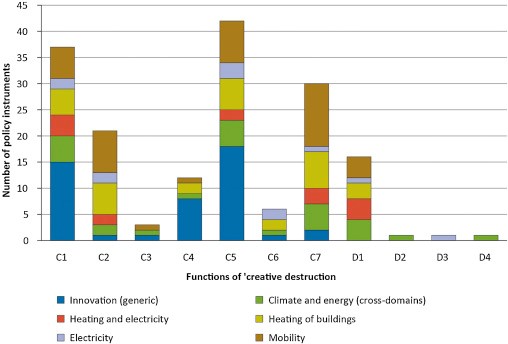Brexit has opened a new era in British politics. Economic uncertainties and a potential slowdown in investment are likely to stay with us in the short to medium term. The Chancellor has made clear that he is prepared to ‘reset’ fiscal policy after Brexit and the Prime Minister announced the launch of a ‘proper industrial strategy’. Energy efficiency is a perfect fit for both. Now is the right time for a major investment in upgrading the UK’s inefficient building stock.

Independent analyses show that when compared to infrastructure projects like the first phase of HS2 and the roll-out of smart meters, efficiency provides very comparable monetary benefits and this is even without quantifying many of the social benefits of energy efficiency such as health and wellbeing improvements. Yet, “we are underinvesting in energy efficiency” as Larry Summers, former US Treasury Secretary, put in a keynote to the World Built Environment Forum earlier this year.
An ambitious investment programme in energy efficiency will create new jobs, support the construction sector, and will reduce consumers’ energy bills thus allowing them to spend more which in turn helps the economy.
Others have done this before
There are many precedents for using public investment in energy efficiency as an economic stimulus. Major economies have previously identified energy efficiency as a key target area for public investment in times of economic downturn. Probably the two most prominent examples are the US and Germany.
Following the 2008 economic crisis, the German government announced the biggest economic stimulus programme since World War II, including £2.6 bn of additional funding for energy efficiency. The main purpose of the programme was to help the struggling construction sector and support jobs.[1]
Similarly, in February 2009, the US Congress passed and the President signed into law an economic stimulus package estimated to cost $787 billion over two years. The American Recovery and Reinvestment Act of 2009 (ARRA) includes the single largest investment in energy efficiency in US history, with approximately £13 billion allocated specifically for efficiency.
There are good reasons for using investment in energy efficiency as a vehicle to stimulate the economy – the macroeconomic benefits of public energy efficiency programmes have been illustrated by economists time and time again.[2]
Economic case also stacks up in the UK
Analyses of energy efficiency investment in the UK context come to similar conclusions:
- Verco and Cambridge Econometrics estimate that if delivered as part of a major infrastructure investment programme for £1 invested by government £3.20 is returned through increased GDP resulting in increased employment of up to 108,000 net jobs per annum.
- A recent study by Frontier Economics calculates that an energy efficiency infrastructure programme could generate £8.7 billion of net-benefits to the economy.[3]
- Focusing on solid wall insulation investment, IPPR and Ricardo Energy & Environment show that a government-funded loan scheme could achieve significant employment and economic impacts.
The evidence suggests that programmes with a high degree of leverage such as loan schemes are likely to deliver the largest net effects due to relatively low subsidy cost compared to the total investment created.
The available evidence suggests that employment creation from investing in energy efficiency is 2 times to 4 times larger than that the fossil fuel-based energy supply sector per unit of energy saved/produced.[4] This is because of the higher labour intensity of the energy efficiency industry and its supply chain. Investments in energy efficiency also compare favourably to renewable energy as the investment costs are offset to some extent or even completely by the energy savings.
Fiscal net-benefits rather than costs
Programmes supporting the installation of energy efficiency measures typically incur a cost in the form of subsidies as well as lost VAT income due to reduced energy consumption. However, those costs are to some extent offset by tax receipts and other revenue streams generated as a result of the activities promoted under an efficiency programme. The main contributors to those positive fiscal impacts are value added tax paid by households taking up energy efficiency measures, income tax paid by employees working along the supply chain, additional corporate tax paid by the companies indirectly benefiting from the subsidies through reduced relative cost of the technologies they supply/ install, and the avoided cost of paying unemployment benefits to workers who were not working previously.
We have known for some time from the German KfW loan scheme that public subsidies are more than offset by the increase in tax revenues and savings in welfare spending due to lower unemployment.[5] There is now an emerging evidence base showing similar effects in Ireland, Croatia[6] and the UK[7] [8].
Now is the time to do this in the UK.
The economic uncertainty caused by the Brexit vote will prevail for some time until Britain’s new status becomes clearer. At the same time, there will be no energy efficiency programme for the able-to-pay sector after 2017 and funds for fuel poverty alleviation are falling short of what is required to achieve the target. The economic evidence is clear – energy efficiency provides a golden opportunity for an economic stimulus in the UK. Major economies around the world have proven that this works, creating jobs and boosting industry. Government borrowing costs are at historical lows allowing investments to be made at much lower cost. Now is the time for the British government to take a bold step and deliver an energy efficiency revolution.
END NOTES
[1] Rosenow, J. (2013): The Politics of the German CO2 Building Rehabilitation Programme. Energy Efficiency 6(2), pp 219-238
[2] Copenhagen Economics (2012): Multiple benefits of investing in energy efficient renovation of buildings: Impact on Public Finances. Commissioned by Renovate Europe
[3] Frontier Economics (2015)
[4] Rosenow, J., Platt, R., Demurtas, A. (2014): Fiscal impacts of energy efficiency programmes – the example of solid wall insulation investment in the UK. Energy Policy 74, pp. 610-620
[5] Kuckshinrichs, W., Kronenberg, T. and Hansen, P. (2010): The Social Return on Investment in the Energy Efficiency of Buildings in Germany. Energy Policy, 38(8), 4317-4329
[6] Mikulić, D., Bakarić, I.R., Slijepčević, S. (2016): The economic impact of energy saving retrofits of residential and public buildings in Croatia. Energy policy 96, pp. 630-64
[7] Rosenow, J., Platt, R., Demurtas, A. (2014): Fiscal impacts of energy efficiency programmes – the example of solid wall insulation investment in the UK. Energy Policy 74, pp. 610-620
[8] Verco and Cambridge Econometrics (2014)
Follow Sussex Energy Group










